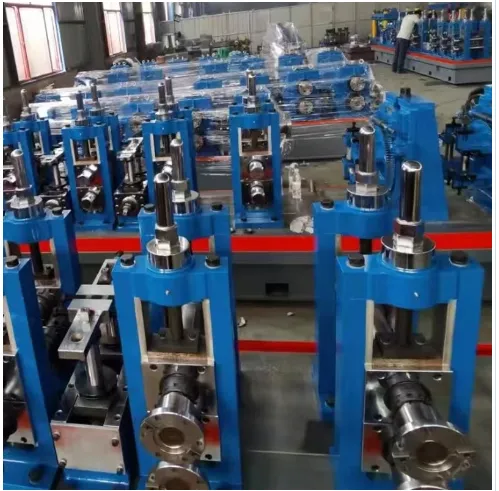Automated Pipe Cutting Machine: Innovation in Efficiency, Accuracy, and Safety
As an indispensable equipment in modern industrial production, Automated Pipe Cutting Machines are increasingly replacing traditional manual cutting methods with their excellent efficiency, precise cutting quality, and significant safety performance. They play a crucial role in fields such as petroleum, natural gas, chemical, and construction. This technological innovation not only improves productivity, but also reduces operating costs and effectively ensures the safety of operators.

The Automated Pipe Cutting Machine achieves a high degree of automation and intelligence in the cutting process by integrating advanced numerical control technology, sensing technology, and robotics technology
The pre programmed cutting scheme can accurately control the motion trajectory of the cutting head in three-dimensional space, ensuring high consistency in cutting angle, size, and surface smoothness. Compared to manual cutting, automatic pipeline welding machines can effectively avoid human errors, significantly improve cutting accuracy, reduce material waste, lower rework rates, and ultimately achieve cost savings.
Efficiency is another significant advantage of Automated Pipe Cutting Machines
ໄດ້ automatic pipe welding machine can work continuously without manual intervention, significantly reducing cutting cycles and improving production efficiency. Especially when dealing with large quantities and repetitive cutting tasks, automated cutting machines can better demonstrate their superiority. By combining with automated logistics systems and intelligent warehousing systems, Automated Pipe Cutting Machines can achieve seamless integration of production processes, further improving overall operational efficiency.
In terms of safety, Automated Pipe Cutting Machines also have unparalleled advantages
The traditional manual cutting process is often accompanied by hazardous factors such as sparks, dust, and noise, which pose potential threats to the physical health of operators. Butt fusion ອຸປະກອນ isolates operators from the cutting area, significantly reducing operational risks and effectively ensuring personnel safety. In addition, some automated cutting machines are equipped with safety protection covers, emergency stop buttons and other safety devices, further enhancing safety performance.
Automated Pipe Cutting Machines are not perfect either
The initial investment cost is relatively high, requiring professional maintenance and upkeep, and customized programming and adjustments may be required for cutting complex shaped pipelines. In addition, higher requirements have been put forward for the technical level of operators.
In summary, the automatic tig pipe welding machine is an important technological innovation in modern industrial production. It greatly improves the efficiency and quality of pipeline cutting, reduces operating costs, and effectively ensures personnel safety due to its high efficiency, precision, and safety. With the continuous development of technology, it is believed that the future Automated Pipe Cutting Machines will become more intelligent and flexible, and play a greater role in more fields, bringing deeper impacts to industrial production.
Automated Pipe Cutting Machine FAQs
What is an Automated Pipe Cutting Machine?
Automated Pipe Cutting Machine is a device controlled by computer numerical control (CNC) or programming, used for efficiently and accurately cutting pipes made of metal, plastic, or other materials. It can automatically complete operations such as measurement, positioning, cutting, and chamfering, and is suitable for large-scale production.
What are the advantages of an Automated Pipe Cutting Machine compared to manual cutting?
High precision: The error can be controlled within ± 0.1mm.
Fast efficiency: Continuous operation, with a speed 510 times faster than manual labor.
Multifunctionality: Supports oblique cutting, bevel cutting, multi angle cutting, etc.
Safety: Reduce the risk of manual contact with cutting tools.
What are the commonly used cutting techniques for Automated Pipe Cutting Machines?
Plasma cutting: suitable for conductive metals, fast speed but may have burrs on the cut.
Laser cutting: High precision, suitable for thin-walled pipes, but with high equipment costs.
Saw blade cutting: suitable for thick walled pipes, with a flat cutting surface.
Water jet cutting: No thermal deformation, suitable for sensitive materials such as titanium alloy.
How to choose a suitable Automated Pipe Cutting Machine?
The following factors need to be considered:
Material type: metal, PVC or stainless steel, etc.
Pipeline size: diameter range (such as Φ 10mm Φ 500mm) and wall thickness.
Cutting requirements: Do you need bevel or multi angle cutting.
Budget: Laser cutting machine>Plasma>Saw blade.
What are the maintenance points of an Automated Pipe Cutting Machine?
Regular cleaning: Remove chips and dust to avoid blockages.
Lubricate moving parts such as guide rails and lead screws.
Check cutting tools/consumables: replace worn saw blades or plasma electrodes in a timely manner.
Calibration system: Ensure the accuracy of sensors and CNC programs.
-
The World of Pipe and Tube Machinery Manufacturers: Precision and Innovationຂ່າວAug.12,2025
-
Revolutionize Your Pipe Manufacturing and Welding with Our Exceptional Machineryຂ່າວAug.12,2025
-
Navigating Pipe Machinery Costs: A Guide to Pricing for Key Equipmentຂ່າວAug.12,2025
-
Essential Pipe Fabrication Equipment: Cutting, Welding, and Support Solutionsຂ່າວAug.12,2025
-
Comprehensive Pipe Processing Machinery: From Cutting to Extrusionຂ່າວAug.12,2025
-
Advanced Pipe Fabrication Tools: Cutting, Beveling, and Welding Solutionsຂ່າວAug.12,2025


